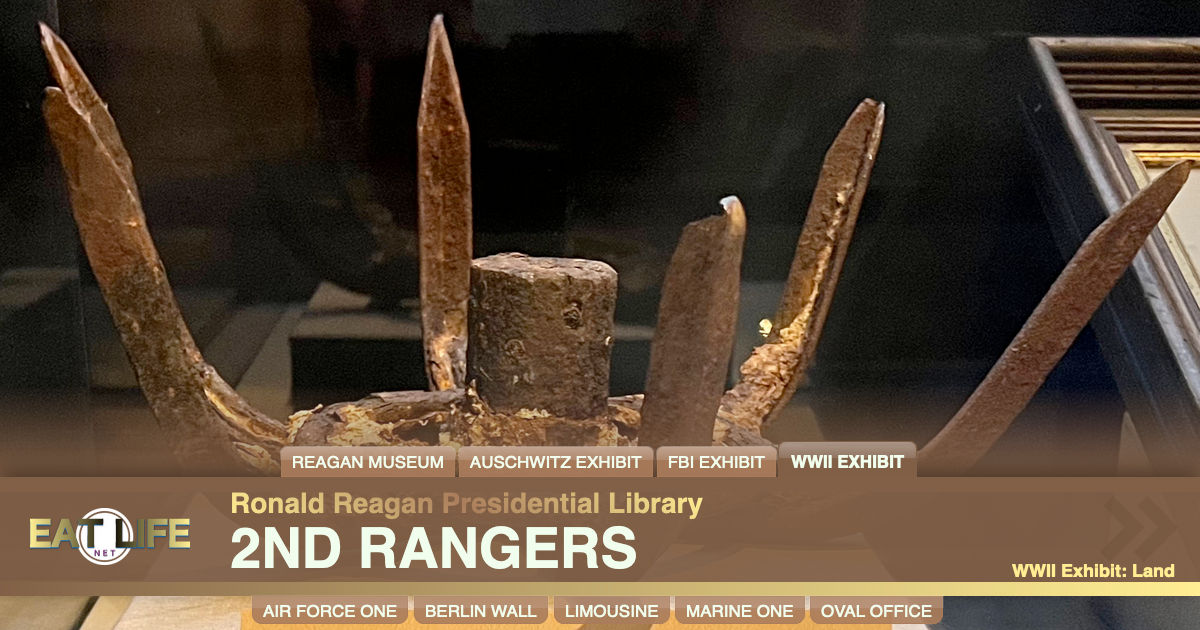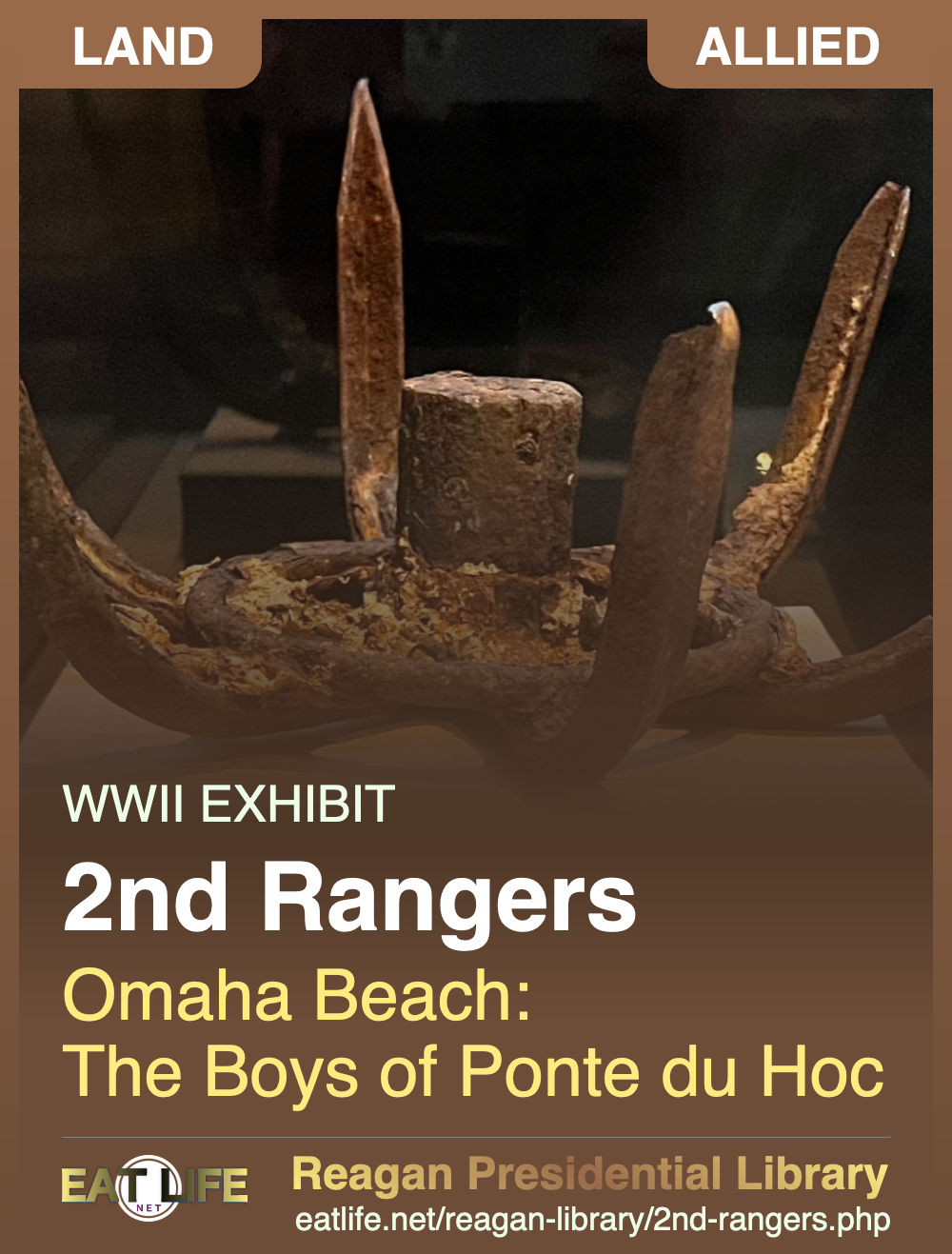Prior to the invasion of Normandy, the German army fortified the area with concrete casemates and gun pits. On D-Day, members of the US Army's 2nd Ranger Battalion were tasked to seize and eliminate six German 155 mm guns atop the formidable Pointe du Hoc clifftop. Due to the guns vantage point, neutralizing them would be critical for the successful landings at the Utah and Omaha Beaches below. Of the 225 Rangers that made it ashore at Pointe du Hoc, Normandy, 77 were killed and 152 wounded.
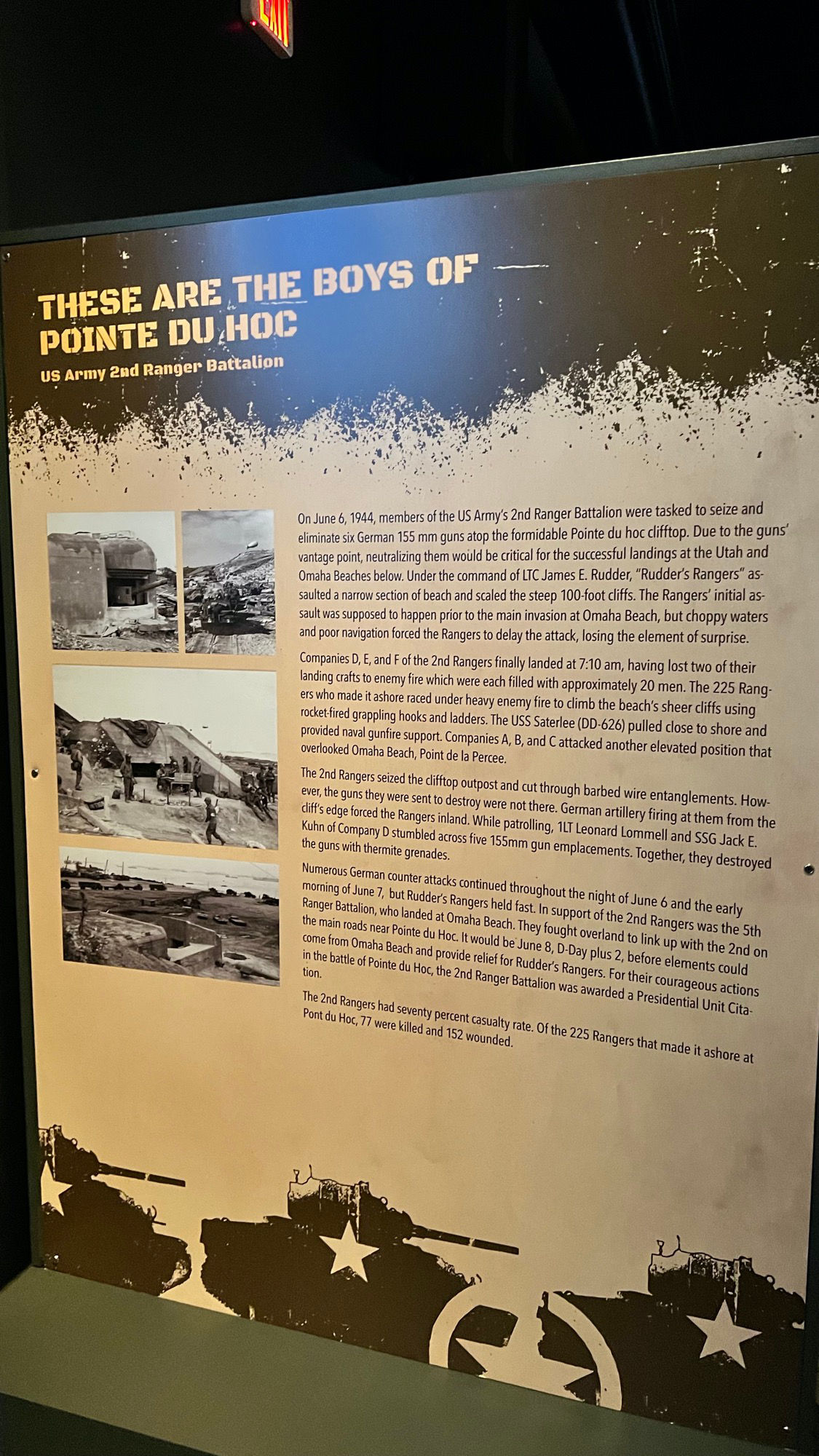
US Army 2nd Ranger Battalion
On June 6, 1944, members of the US Army's 2nd Ranger Battalion were tasked to seize and eliminate six German 155 mm guns atop the formidable Pointe du Hoc clifftop. Due to the guns vantage point, neutralizing them would be critical for the successful landings at the Utah and Omaha Beaches below. Under the command of LTC James E. Rudder, "Rudder's Rangers" assaulted a narrow section of beach and scaled the steep 100-foot cliffs. The Rangers' initial assault was supposed to happen prior to the main invasion at Omaha Beach, but choppy waters and poor navigation forced the Rangers to delay the attack, losing the element of surprise.
Companies D, E, and F of the 2nd Rangers finally landed at 7:10 am, having lost two of their landing crafts to enemy fire which were each filled with approximately 20 men. The 225 Rangers who made it ashore raced under heavy enemy fire to climb the beach's sheer cliffs using rocket fired grappling hooks and ladders. The USS Saterlee (DD-626) pulled close to shore and provided naval gunfire support. Companies A, B, and C attacked another elevated position that overlooked Omaha Beach, Point de la Percee.
The 2nd Rangers seized the clifftop outpost and cut through barbed wire entanglements. However, the guns they were sent to destroy were not there. German artillery firing at them from the cliff's edge forced the Rangers inland. While patrolling, 1LT Leonard Lommell and SSG Jack E. Kuhn of Company D stumbled across five 155mm gun emplacements. Together, they destroyed the guns with thermite grenades.
Numerous German counter attacks continued throughout the night of June 6 and the early morning of June 7, but Rudder's Rangers held fast. In support of the 2nd Rangers was the 5th Ranger Battalion, who landed at Omaha Beach. They fought overland to link up with the 2nd on the main roads near Pointe du Hoc. It would be June 8, D-Day plus 2, before elements could come from Omaha Beach and provide relief for Rudder's Rangers. For their courageous actions in the battle of Pointe du Hoc, the 2nd Ranger Battalion was awarded a Presidential Unit Citation.
The 2nd Rangers had seventy percent casualty rate. Of the 225 Rangers that made it ashore at Pointe du Hoc, 77 were killed and 152 wounded.
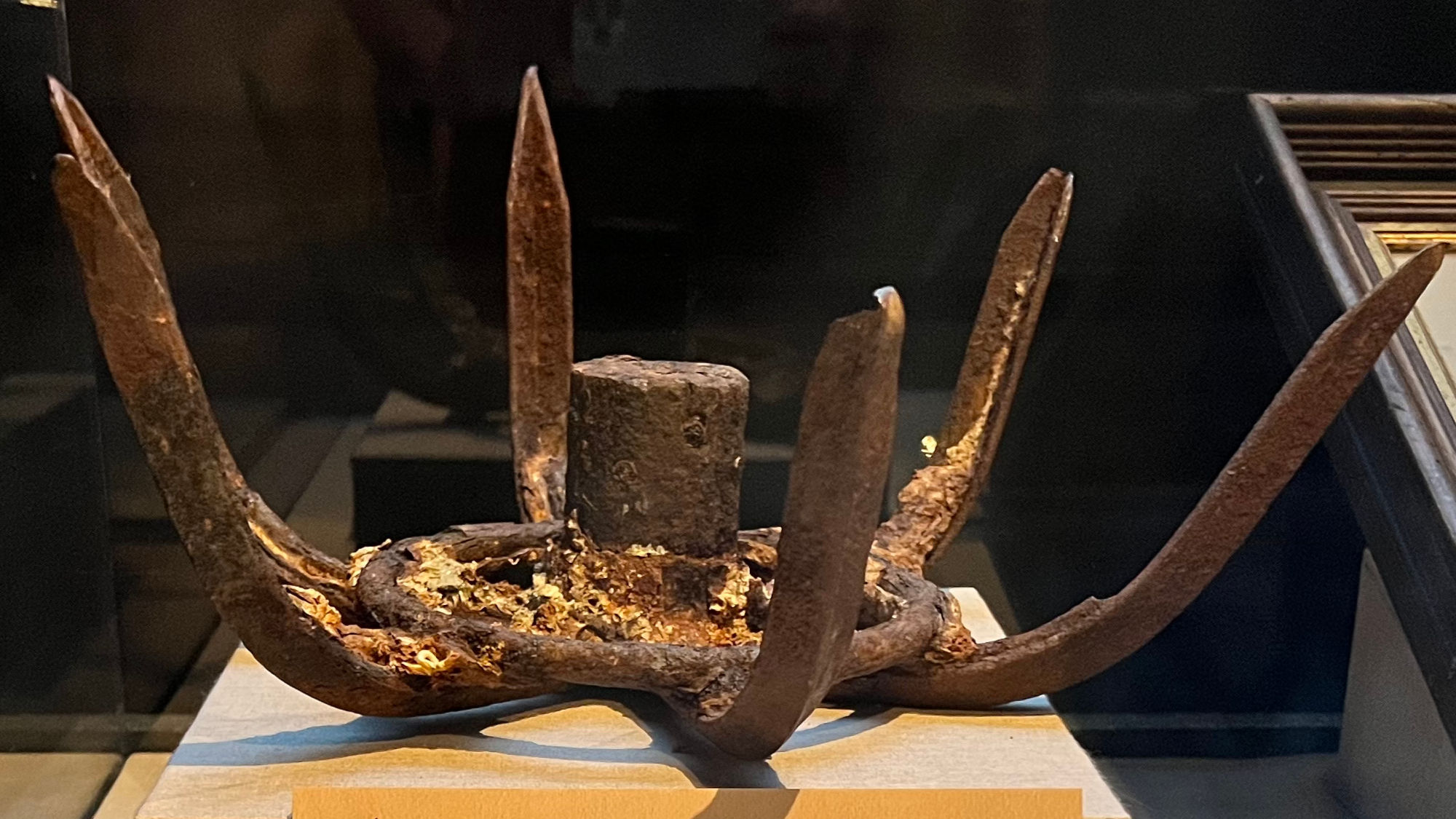
June 6, 1944
The 2nd Rangers use grappling hooks when they scaled the 100 foot tall cliffs.
One of only two known to exist.
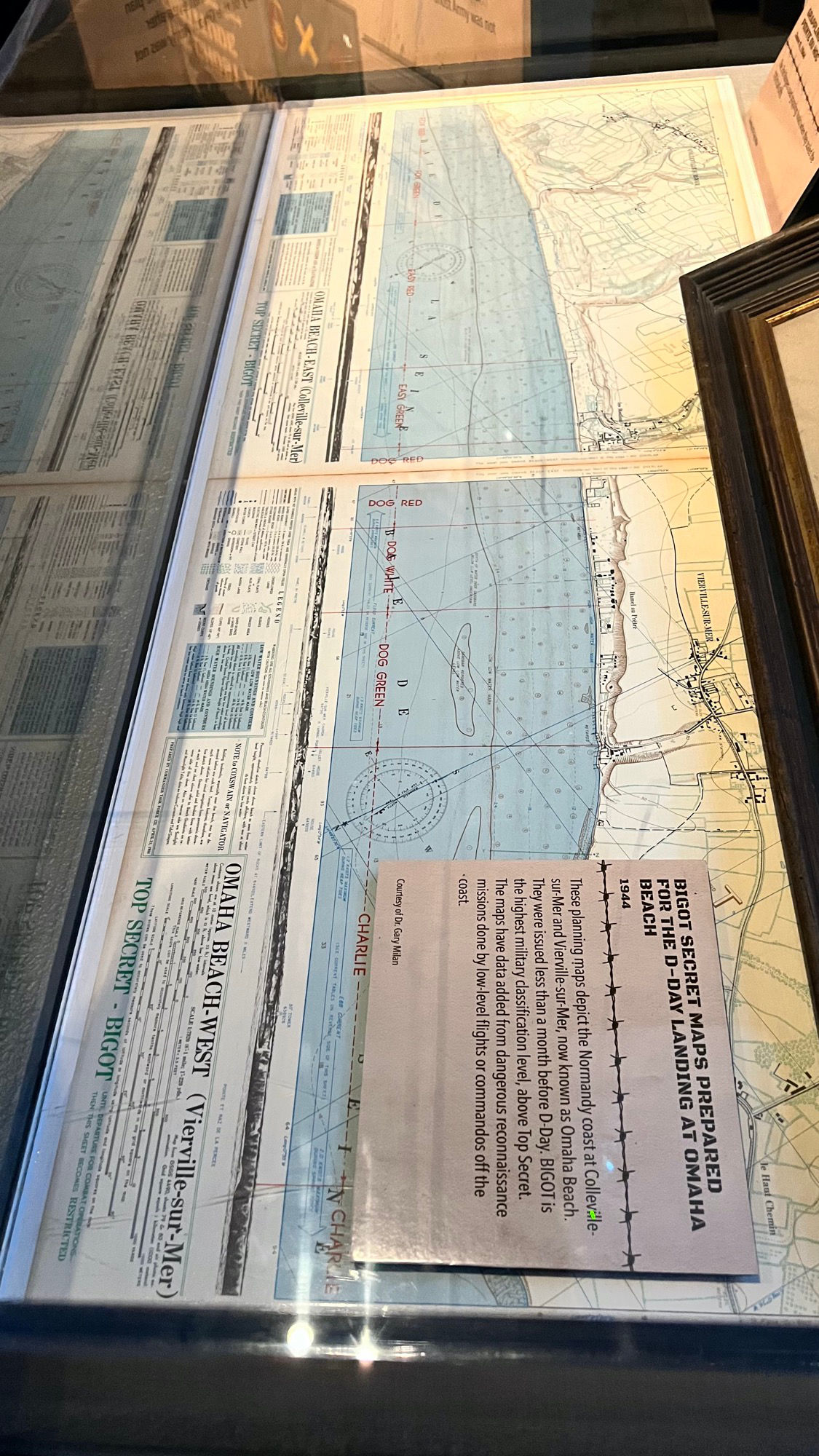
Prepared for the D-Day Landing at Omaha Beach
1944
These planning maps depict the Normandy coast at Collevile-sur-Mer and Vierville-sur-Mer, now known as Omaha Beach. They were issued less than a month before D-Day. Bigot is the highest military classification level, above Top Secret. The maps have data added from dangerous reconnaissance missions done by low-level flights or commandos off the coast.
WIKIPEDIALa Pointe du Hoc is a promontory with a 110 ft cliff overlooking the English Channel on the northwestern coast of Normandy in the Calvados department, France.
In World War II, Pointe du Hoc was the location of a series of German bunkers and machine gun posts. Prior to the invasion of Normandy, the German army fortified the area with concrete casemates and gun pits. On D-Day, the United States Army Provisional Ranger Group attacked and captured Pointe du Hoc after scaling the cliffs. United States generals including Dwight D. Eisenhower had determined that the place housed artillery that could slow down nearby beach attacks.Pointe du Hoc lies 4 miles west of the center of Omaha Beach. As part of the Atlantic Wall fortifications, the prominent cliff top location was fortified by the Germans.
The battery was initially built in 1943 to house six captured French First World War vintage GPF 155mm K418(f) guns positioned in open concrete gun pits. The battery was garrisoned by the 2nd Battery of Army Coastal Artillery Battalion 1260. To defend the promontory from attack, elements of the 352nd Infantry Division were also stationed at the battery.
To provide increased defensive capability, the Germans began to improve the defenses of the battery in the spring of 1944, with enclosed H671 concrete casemates being started and the older 155mm guns displaced. The plan was to build six casemates but two were unfinished when the location was attacked. The casemates were built over and in front of the circular gun pits, which housed the 155mm guns.
Also built was a H636 observation bunker and L409a mounts for 20mm Flak 30 anti-aircraft guns. The 155mm guns would have threatened the Allied landings on Omaha and Utah beaches when finished, risking heavy casualties to the landing forces.
In the months before D-Day the Germans were recorded by Allied Intelligence removing their guns one by one as they re-developed the site with the final aim of 4 casemates facing Utah Beach and the possibility of 2 x 155mm guns in open emplacements. During the preparation for Operation Overlord it was determined by Lt Col. James Earl Rudder that Pointe du Hoc should be attacked by ground forces, to prevent the Germans using the casemates.
The Battle
The assault force was carried in ten landing craft, with another two carrying supplies and four DUKW amphibious trucks carrying the 100-foot ladders requisitioned from the London Fire Brigade. One landing craft carrying troops sank, drowning all but one of its occupants; another was swamped. One supply craft sank and the other put the stores overboard to stay afloat. German fire sank one of the DUKWs. Once within a mile of the shore, German mortars and machine guns fired on the craft.These initial setbacks resulted in a 40-minute delay in landing at the base of the cliffs, but British landing craft carrying the Rangers finally reached the base of the cliffs at 7:10 am with approximately half the force it started out with. The landing craft were fitted with rocket launchers to fire grapnels and ropes up the cliffs. As the Rangers scaled the cliffs, the Allied ships USS Texas (BB-35), USS Satterlee (DD-626), USS Ellyson (DD-454), and HMS Talybont (L18) provided them with fire support and ensured that the German defenders above could not fire down on the assaulting troops. The cliffs proved to be higher than the ladders could reach.
The original plans had also called for an additional, larger Ranger force of eight companies (Companies A and B of the 2nd Ranger Battalion and the entire 5th Ranger Battalion) to follow the first attack, if successful. Flares from the cliff tops were to signal this second wave to join the attack, but because of the delayed landing, the signal came too late, and the other Rangers landed on Omaha instead of Pointe du Hoc. The added impetus these 500-plus Rangers provided on the stalled Omaha Beach landing has been conjectured to have averted a disastrous failure there, since they carried the assault beyond the beach, into the overlooking bluffs and outflanked the German defenses.
When the Rangers made it to the top at Pointe du Hoc, they had sustained 15 casualties. "Ranger casualties on the beach totalled about 15, most of them from the raking fire to their left". The force also found that their radios were ineffective. Upon reaching the fortifications, most of the Rangers learned for the first time that the main objective of the assault, the artillery battery, had been removed. The Rangers regrouped at the top of the cliffs, and a small patrol went off in search of the guns. Two different patrols found five of the six guns nearby (the sixth was being fixed elsewhere) and destroyed their firing mechanisms with thermite grenades.
Leonard Lomell of the 2nd Ranger Battalion maintained that he and Ranger Jack Kuhn found the guns completely by accident after walking down a tree-lined lane, whilst on patrol.
Multiple copies of the Rangers orders were released in 2012 by the US National Archives, indicating that Lt. Col. Rudder had been told of the guns' removal prior to landing. His D-Day orders went beyond the taking of Pointe du Hoc and remained consistent: Land at Pointe du Hoc & Omaha Beach; advance along the coast; take the town of Grandcamp, attack the Maisy Batteries and reach the "D-Day Phase Line" (close to Osmanville) two hours before dark. The Rangers could then repel counterattacks along the Grandcamp-Vierville road, via the Isigny-Bayeux road or diagonally across open fields. They could also prevent mobile 150mm artillery getting within a 12-mile range of the beachhead.
The Rangers trained specifically for the 12-mile inland march during the Slapton Sands exercises in England, and the First Infantry Division was also given the same "D-Day Phase Line" objective.
Once captured, Pointe du Hoc did not result in any observational disadvantage for the German Army as they already used the taller Chateau, houses and churches in the area.
The Small Unit Actions Report written by US Army Intelligence, states that there were times (some hours) when the Rangers did not see a single German after the initial fighting. Historians suggest this gave Lt. Col. Rudder the time to have continued with his objectives. No documentary evidence has been produced ordering Rudder to stay and "guard the road" behind Pointe du Hoc or wait for reinforcements. Yet that version of events is often stated as factual in books written prior to 2012. That said, after two days of fighting, 77 of the 225 soldiers that had landed at the Pointe had been killed, with another 152 wounded, showing that there was indeed fierce fighting occurring.
The costliest part of the battle for Pointe du Hoc for the Rangers came after the successful cliff assault. Determined to hold the vital high ground, yet isolated from other Allied forces, the Rangers fended off several counter-attacks from the German 914th Grenadier Regiment. The 5th Ranger Battalion and elements of the 116th Infantry Regiment headed towards Pointe du Hoc from Omaha Beach. However, only twenty-three Rangers from the 5th were able to link up with the 2nd Rangers during the evening of 6 June 1944. During the night the Germans forced the Rangers into a smaller enclave along the cliff, and some were taken prisoner.
It was not until the morning of 8 June that the Rangers at Pointe du Hoc were finally relieved by the 2nd and 5th Rangers, plus the 1st Battalion of the 116th Infantry, accompanied by tanks from the 743rd Tank Battalion.
When the Rangers began suffering heavy losses, brief consideration was given to sending in the 84-man Marine Detachment aboard the battleship USS Texas on the morning of 7 June. At the last minute, word was passed down through the Army chain of command that no Marines would be allowed to go ashore, not even providing armed escort on landing craft ferrying Army troops or supplies.
At the end of the two-day action, the initial Ranger landing force of 225+ was reduced to about 90 fighting men. In the aftermath of the battle, some Rangers became convinced that French civilians had taken part in the fighting on the German side. A number of French civilians accused of shooting at US forces or of serving as artillery observers for the Germans were executed.
BATTLE TIMELINE: June 6, 1944 06:39 H-Hour – D, E and F companies of 2nd Ranger Battalion approach the Normandy coast in a flotilla of twelve craft. 07:05 Strong tides and navigation errors mean the initial assault arrives late and the 5th Ranger Battalion as well A and B companies from 2nd Battalion move to Omaha Beach instead. 07:30 Rangers fight their way up the cliff and reach the top and start engaging the Germans across the battery. Rangers discover the casemates are empty. 08:15 Approximately 35 Rangers reach the road and create a roadblock. 09:00 Five German guns are located and destroyed using thermite grenades. Day The Rangers repel several German counter-attacks. Evening One patrol from the 5th Rangers that landed at Omaha beach make it through to join the Rangers at Pointe du Hoc. June 7, 1944 Morning The Rangers continue to defend an even smaller area on Pointe du Hoc against German counter-attacks. Afternoon A platoon of Rangers arrives on an LST, with wounded removed. June 8, 1944 Morning The Rangers are relieved by troops arriving from Omaha Beach. WIKIPEDIA
WIKIPEDIAFormation of Ranger Battalions
On 1 April 1943 the 2nd Ranger Battalion was formed at Camp Forrest, Tennessee, along with the 5th Ranger Battalion. Both battalions were officially activated in September 1943 and shipped to Great Britain where they were prepared for Operation Overlord as part of six Ranger battalions of the Second World War.On 6 June 1944, Dog, Easy, and Fox Companies, commanded by Lieutenant Colonel James Rudder, landed at Pointe du Hoc from LCA landing craft and specially modified DUKW "Ducks" operated by the Royal Navy. The 225 Rangers had set off from Britain to launch an assault upon the cliffs overlooking the English Channel. In order to augment the strength of the 2nd Battalion, members of the Provisional Ranger Group were assigned as well. Several landing craft containing Rangers and supplies capsized in the stormy waters and many Rangers drowned due to heavy equipment, but others were saved and hoisted into other DUKWs to participate in the attack.
The Rangers had planned to land at the base of the cliffs at 0600 hours, however, because of a navigational error, they landed nearly an hour late. This cost the lives of more Rangers as well as the element of surprise. During the attack, the 190 remaining Rangers scaled the cliffs utilizing rope ladders, but only 90 Rangers were still able to bear arms after two days of relentless fighting. During the assault, 2nd Battalion managed to achieve their primary objective, disabling a battery of 155mm French artillery captured by the Germans. These guns were to be aimed at Utah Beach, however, the Rangers prevented their use, saving American lives on the shores of Normandy.
Meanwhile, Able, Baker, and Charlie Companies landed along with the 5th Rangers, the 1st Infantry Division, and the 29th Infantry Division at Omaha Beach. They suffered extremely heavy casualties but were able to complete their D-Day objectives. Able suffered up to 96% casualties with just two men making it off the beaches. The 2nd Rangers were later involved in the Battle for Brest and the Battle of Hurtgen Forest where they led the assault on Hill 400, Bergstein.
The battalion was deactivated after the war, together with the 5th and 6th Battalion. Later Reformed into the modern day 2nd Ranger Battalion in 1974.






